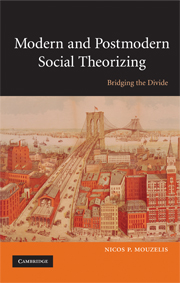Book contents
- Frontmatter
- Contents
- List of figures
- Acknowledgements
- Introduction
- Part I The theoretical background: the development of the agency–structure problematic
- Part II Parsonian and post-Parsonian developments
- Part III Agency and structure: reworking some basic conceptual tools
- 6 Social and system integration: Lockwood, Habermas and Giddens
- 7 The subjectivist–objectivist divide: against transcendence
- 8 Habitus and reflexivity: restructuring Bourdieu's theory of practice
- Part IV Bridges between modern and late/postmodern theorizing
- Part V Towards a non-essentialist holism
- Instead of Conclusion: Twelve rules for the construction of an open-ended holistic paradigm
- Appendix: In defence of ‘grand’ historical sociology
- References
- Index
7 - The subjectivist–objectivist divide: against transcendence
Published online by Cambridge University Press: 05 June 2012
- Frontmatter
- Contents
- List of figures
- Acknowledgements
- Introduction
- Part I The theoretical background: the development of the agency–structure problematic
- Part II Parsonian and post-Parsonian developments
- Part III Agency and structure: reworking some basic conceptual tools
- 6 Social and system integration: Lockwood, Habermas and Giddens
- 7 The subjectivist–objectivist divide: against transcendence
- 8 Habitus and reflexivity: restructuring Bourdieu's theory of practice
- Part IV Bridges between modern and late/postmodern theorizing
- Part V Towards a non-essentialist holism
- Instead of Conclusion: Twelve rules for the construction of an open-ended holistic paradigm
- Appendix: In defence of ‘grand’ historical sociology
- References
- Index
Summary
As I have argued in chapter 1, the dominance of Parsonian functionalism in the field of sociological theory during the early postwar period gave way to extreme fragmentation when Parsons' grand synthesis was challenged by a variety of competing paradigms (symbolic interactionism, ethnomethodology, phenomenological sociology, non-Marxist conflict theory, structuralism/post-structuralism, etc.). This proliferation of approaches led to compartmentalization, with each theoretical tradition claiming the monopoly of truth and busily building impregnable barriers (methodological, epistemological and ontological) to inter-paradigmatic, open-ended communication.
The 1980s and 1990s brought a reaction to the ‘war of paradigms’ with attempts from various quarters to overcome the fragmentation of the previous two decades. This reaction took two main forms. On the one hand, post-structuralism presupposed the radical dissolution of boundaries not only between social-science paradigms but also between social-science disciplines and sub-disciplines (economics, sociology, social psychology, anthropology, etc.), or even between the social sciences and philosophy, literature, linguistics, etc. This extreme form of theoretical dedifferentiation led to a situation where complex social phenomena were reductively explained in terms of signs, texts, ‘desire’, etc. (Mouzelis, 1995b: 41–68).
A more constructive reaction to fragmentation and compartmentalization was the endeavour to transcend the boundaries between existing paradigms. For instance, Giddens' structuration theory (1984) is supposed to provide a ‘transcending’ conceptual framework which draws elements from what he calls interpretative sociologies, structural sociologies and structuralist ones.
- Type
- Chapter
- Information
- Modern and Postmodern Social TheorizingBridging the Divide, pp. 107 - 130Publisher: Cambridge University PressPrint publication year: 2008

